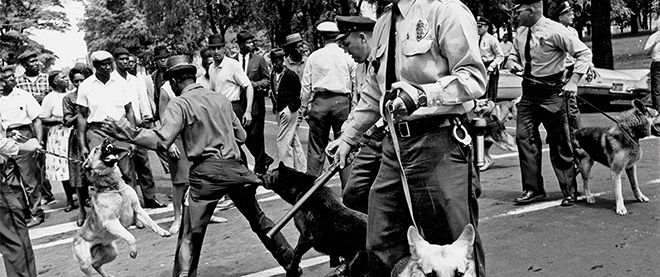
Charles Moore; Reproduction from the Black Star Collection at Ryerson University.
Courtesy of the Ryerson Image Centre
Ryerson University Wishes Upon a Shooting Black Star
How did the most important international collection of documentary photography end up at a new museum in Toronto?
—
In 2003, the Toronto-based photography dealer Stephen Bulger was hired for a dream assignment. An anonymous client (who requested Bulger sign a confidentiality agreement) asked him to appraise the Black Star archive. Possessing one of the world’s most important and comprehensive accumulations of 20th-century documentary photography, the Black Star photo agency was founded in New York City by three German Jewish intellectuals who fled Nazi Germany. With 292,000 prints, created by more than 6,000 photographers, Black Star is still in business today but had put its historic archive on the market.
Bulger describes the job as “mind-blowing.” Not only did it involve studying photographs by such masters as Robert Capa, Henri Cartier-Bresson and Bill Brandt, it was a review of history itself. The collection includes pictures of every internationally newsworthy moment from the 1930s to the 1980s. It was exhilarating to appraise the images as photographic artifacts, says Bulger, after having seen so many of them in books, magazines, or newspapers.
When Kurt Safranski, Kurt Kornfeld and Ernest Meyer established Black Star in 1935, they did so with a sophisticated understanding of photojournalism not yet present in America. German newspapers and magazines had been in the vanguard of editorial communications and design ever since the first mass-marketed hand-held camera, the Leica, invented by a German optical engineer, hit the market in the 1920s. Not bound by heavy tripods and cumbersome apparatus, the camera used easy-to-load 35mm film. Photographers embraced it to capture images spontaneously and in quick succession, an aesthetic soon represented in the European illustrated press, where stories were told through pictures.
In New York the three émigrés began commissioning photographers to document current events for photo-based publications. Their timing couldn’t have been better. Within months of their start-up, publisher Henry Luce relaunched Life and a decades-long collaboration between the agency and the magazine began. Countless other clients, including Newsweek, Time and The Saturday Evening Post soon followed.
It was this formidable archive that Bulger’s client purchased, for an undisclosed amount. When in 2004 he called to discuss his plans to donate the collection, Bulger suggested Ryerson, his alma mater, which already had an important photography collection as well as two famed programs—one in photo preservation, the other in collections management. Also, Ryerson had an ambitious plan under way for a new building, gallery and resource centre. So in 2005, Bulger’s client donated the collection to Ryerson along with $7 million, which would allow the university to build a proper vault to house the archive—the largest gift of cultural property ever made to a Canadian university.
Next week, when the Ryerson Image Centre opens, its luminous facade displaying 10-foot-high reproductions from the Black Star collection, it will become Canada’s first major institution devoted exclusively to collecting, researching and exhibiting lens-based art. The goal, says Doina Popescu, the centre’s director, is to have it become an international destination for photography, film and new media. And “the ignition for all of this was the donation of the Black Star collection,” says Popescu.
Fittingly, the inaugural exhibition, Archival Dialogues: Reading the Black Star Collection, features original pieces responding to images from the famous archive by many of Canada’s most important artists, including Michael Snow, Stan Douglas and Vera Frenkel.
As for that generous donor, his identity was revealed in a dramatic flourish just weeks ago to be Vancouver entrepreneur Jim Pattison, named by Forbes as Canada’s fourth-wealthiest man. Details of the bequest emerged in court documents after an accountant and his partner, an art consultant, who were working for Pattison, were convicted for their failures to remit $82,250 in GST that they collected for the transaction and the $1,175,000 fee they earned.
But, for Bulger, far more important than the financial details of how the Ryerson Image Centre came into existence, is its future legacy. That, he says, is described with just one word: “Priceless.”